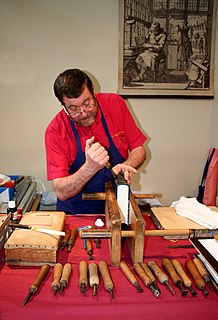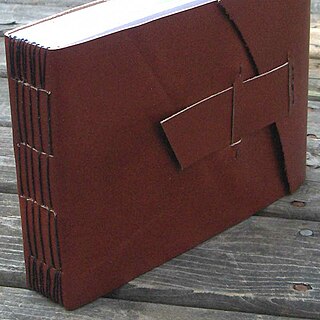VeloBind is a type of book binding often offered at copy and print shops. Velobinding involves punching several small holes along the edge of an unbound book. A strip of plastic with rigid tines is inserted into the holes from the top of the book, and a strip with corresponding holes is placed on the back with the tines protruding through. The book is then placed in a machine that holds the book tightly while the excess length of the tines is cut and the tips melted to seal the bind. The term "VeloBind" is a trademark of the General Binding Corporation, but is regularly used generically to refer to this process, though strip binding is also sometimes used.

Bookbinding is the process of physically assembling a book of codex format from an ordered stack of paper sheets that are folded together into sections or sometimes left as a stack of individual sheets. The stack is then bound together along one edge by either sewing with thread through the folds or by a layer of flexible adhesive. Alternative methods of binding that are cheaper but less permanent include loose-leaf rings, individual screw posts or binding posts, twin loop spine coils, plastic spiral coils, and plastic spine combs. For protection, the bound stack is either wrapped in a flexible cover or attached to stiff boards. Finally, an attractive cover is adhered to the boards, including identifying information and decoration. Book artists or specialists in book decoration can also greatly enhance a book's content by creating book-like objects with artistic merit of exceptional quality.
General Binding Corporation is an American office supplies manufacturer which makes equipment and supplies for binding, lamination, and other presentation products. The company is part of ACCO Brands. Its headquarters are in Lake Zurich, Illinois. ACCO's brands include GBC, Quartet, Swingline, AT-A-GLANCE, Day-Timer, Mead, FiveStar and many others.
Contents
Though velobinding is intended to be permanent, the binding can be carefully removed using a utility knife or the special cutting tool included with the binding machine.
Hardcover books can be created using the VeloBind process. Two adhesive inner covers are bound with the prospective contents. These adhesive pages are applied to the inside of a paperboard hard case, itself decoratively covered and containing an adhesive strip that matches with the spine. Book information can be embossed onto the cover with a contrasting foil. VeloBind hardcovers are often used to preserve theses and dissertations.

A hardcover or hardback book is one bound with rigid protective covers. It has a flexible, sewn spine which allows the book to lie flat on a surface when opened. Following the ISBN sequence numbers, books of this type may be identified by the abbreviation Hbk.

Paperboard is a thick paper-based material. While there is no rigid differentiation between paper and paperboard, paperboard is generally thicker than paper and has certain superior attributes such as foldability and rigidity. According to ISO standards, paperboard is a paper with a grammage above 250 g/m2, but there are exceptions. Paperboard can be single- or multi-ply.
It is possible to take a soft covered Velo-bound book, remove the old binding and cover, and re-bind it with a hard cover, which may be pre-embossed for more a more impressive appearance. This rapid up-grade was the cause of the short-lived motto "Soft to hard in 30 seconds!" That was first done when the firm was located in Sunnyvale, California.

Sunnyvale is a city located in Santa Clara County, California. As of the 2010 United States Census, the population was 140,095.
There are a number of different styles of Velobind that are available from GBC. The most common style of Velobind strips have eleven pins that are equally spaced across the spine. This style of strips is used by a hot knife binding machine such as the GBC V800pro, Velobind System 2 or Velobind System Three Pro. All of those machines use a heated knife to permanently weld documents in place.
Other styles of Velobind binding strips include four pin reclosable strips and six pin reclosable strips. Four pin Velobind strips are designed for use with either an eleven hole pattern or with a four hole pattern. Six pin strips are designed for use with the personal velobinder which has now been discontinued. Both of these styles of strips allow users to edit their documents by simply snapping the excess portion of the pins into the back of the receiving strip.
One other style of GBC Velobind strips is the 111 or One-Eleven binding strips. The style uses a strip with serrated pins. The machine compresses the spine together locking the pages in place and then cuts the excess portion of the pins off to finish the document. The GBC 111 Velobind machine has been discontinued for many years and the supplies for this binding style are becoming difficult to find.










